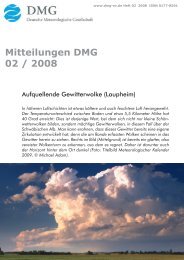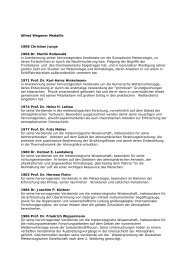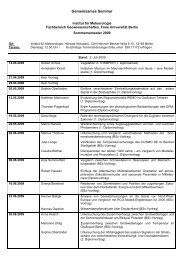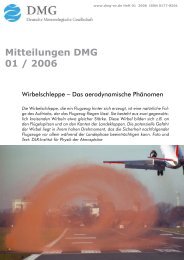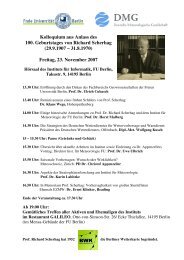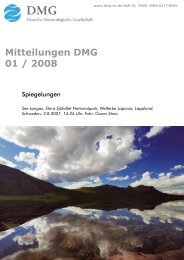Proceedings zur 6. Fachtagung BIOMET - Deutsche ...
Proceedings zur 6. Fachtagung BIOMET - Deutsche ...
Proceedings zur 6. Fachtagung BIOMET - Deutsche ...
Erfolgreiche ePaper selbst erstellen
Machen Sie aus Ihren PDF Publikationen ein blätterbares Flipbook mit unserer einzigartigen Google optimierten e-Paper Software.
Plants, especially trees usually experience a fluctuating water supply during their life cycle<br />
due to continuously changing climatic factors. The water stress or dryness leads to closing the<br />
stomata, whereby the transpiration is strongly reduced (Gottschalck et al., 2001). That is an<br />
important strategy to protected trees against loss of water in dryness.<br />
Results of the German network project VERTIKO (BERNHOFER and KÖSTNER, 2006) and<br />
Eva_grips showed that commonly used meso-models like Lokalmodell (German Weather<br />
Service, HERET et al., 2006) often overestimate evapotranspiration (ET) of vegetated surfaces<br />
during dry periods. This is, among others, probably due to the lack of a plant-specific coupling<br />
between the soil water content and the physiological reactions of leaf stomata in the<br />
implemented simple SVAT modules. This leads to a continuous increase of ET caused by an<br />
increase of the atmospheric saturation deficit. Consequently this leads to an overestimation of<br />
water transport from the surface to the atmosphere. Therefore, meteorological models should<br />
include a mechanism to couple the soil water with a physiologically based plant control of ET<br />
for a more realistic simulation of water transport from the surface to the atmosphere.<br />
This study presents an approach to describe the above mentioned coupling mechanism by<br />
upgrading the coupled vegetation boundary layer model HIRVAC using a dependence of<br />
stomatal reaction on soil moisture change in the included gas exchange model PSN<strong>6.</strong><br />
2 Methods<br />
2.1 Model description<br />
Fig. 1: Scheme of the HIgh Resolution Vegetation Atmosphere Coupler (HIRVAC)<br />
Abb. 1: Schema des HIgh Resolution Vegetation Atmosphere Coupler (HIRVAC)<br />
HIRVAC (HIgh Resolution Vegetation Atmosphere Coupler) is a 1.5 dimensional atmospheric<br />
boundary layer model (MIX et al., 1994; GOLDBERG and BERNHOFER, 2001; BAUMS et<br />
al., 2005) which is coupled with the mechanistic photosynthesis module for C3 plants PSN6<br />
(FALGE et al., 1996). The model has a resolution of 120 layers between the lower (surface)<br />
and the upper model boundary (typical 2 km above the ground) whereas the layer distance<br />
increases with a geometric progression. Vegetation is considered by extension of the basic<br />
model equations for momentum, temperature and humidity with additional source terms<br />
which are solved numerically for each canopy model level. These terms are included in the<br />
first calculation levels above the surface and are parameterized with vegetation parameters<br />
dependent on type and vertical structure of vegetation. The high vertical resolution of<br />
HIRVAC in the first decametres above the ground (60 layers between 0 and 30 m) permits a<br />
very detailed differentiation of structured vegetation like forests (Fig.1).<br />
112






